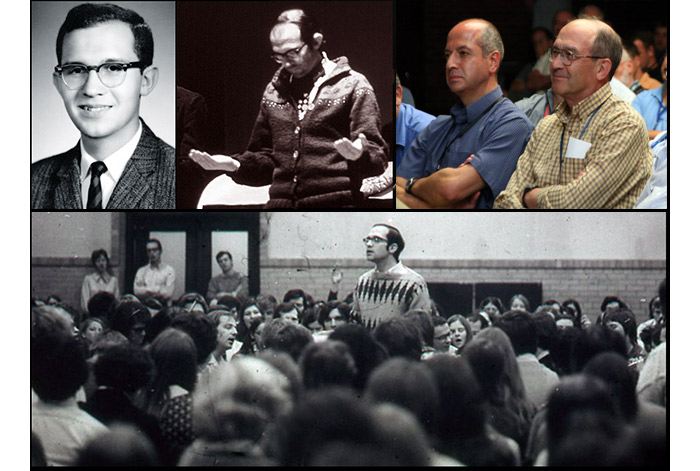The Foundations
Stephen B. Clark was born on June 1st, 1940 in New York City. He attended Bellerose Public School on Long Island and then Peddie Boys School in Hightstown, New Jersey. In 1958 he began his university studies at Yale University in New Haven, Connecticut. There, in 1960, he was converted to Christianity as he looked to ground his life in the truth. Reading about Christianity convinced his intellect, but two books about Francis of Assisi were key in bringing him to a personal faith. The books were The Little Flowers and The Mirror of Perfection. In reading these he saw that being a Christian involved a living, personal relationship with Jesus –that there was more to faith than intellectual assent. Like Francis, Steve quickly made a concrete response to live as a radical disciple of Christ and to call others to a serious personal response as well. This decision became the seed for Steve living Single for the Lord.
Steve then got involved with the Morehouse Catholic Chaplaincy at Yale. He studied the catechism in depth and presented himself for baptism. The chaplaincy also had a “community” and Steve saw that those involved in Christian activities tended to grow In faith and holiness, while those who only attended church on Sunday seemed to struggle with their faith and often left the church during their university years. It was, in part, this experience that began to form the basis of Steve’s vision of building a “community of disciples on mission.”
In the autumn of 1963 he began work on a doctorate at the University of Notre Dame in South Bend, Indiana. There he connected with the Cursillo Movement, which he had encountered as a summer missionary in Latin America. Bringing others to Christ was the main focus of Cursillo but they also formed mission based communities. At the time Cursillo was only beginning in the United States and according Cursillo’s rules, Steve was still too voung to attend or lead a retreat – he attended one anyway and then helped put on the first Cursillo retreat in South Bend. In less than two years he was asked to serve on their National Secretariat in East Lansing, Michigan.
Steve was interested in how he could be more effective in the work of building a transformative community. He began to believe something of God’s power was missing and wondered if it was to be found among Pentecostals. This conviction was deepened after he attended his first Pentecostal prayer meeting and began reading The Cross and the Switchblade.
He and Ralph Martin shared about what they were learning at the national Cursillo gathering in 1966. They recommended to the other leaders that they all read The Cross and the Switchblade. Early in 1967, two of those who read the book, William Storey and Ralph Kiefer, sponsored a retreat that became known as the Duquesne Weekend, an event from which the Catholic Charismatic Renewal came forth. Like so many others at the beginning of this Renewal, Steve experienced the baptism of the Holy Spirit through the laying on of hands by someone who had previously had the same experience.
The Formation of Community
Steve had a vision for where he believed the Church should be going and he applied his whole life toward that goal: building committed Christian communities comprised of radical disciples who wanted to do mission with the power manifested in the early church.
Much of the template for how to do this was already written by 1966 and was part of the action plan for working with the outreach to students at Michigan State University, but it was the charismatic experience of the Holy Spirit and the transformative effect that it had on people’s lives that made the template live.
In the autumn of 1967 Steve, Ralph Martin, Gerry Rauch, and Jim Cavnar moved to Ann Arbor, Michigan, (Things charismatic weren’t well received in Lansing at first.) In Ann Arbor, they began a charismatic prayer meeting that met on Thursday nights with a dozen people in a two-bedroom apartment above Campus Corner Drug Store.
Within weeks, more than one hundred people were attending, so they moved the prayer meeting to the basement of St. Mary’s Student Chapel. People began corning from all over the American Midwest, some driving four hours each way to learn more about the work of the Holy Spirit.
By 1970, people were traveling hundreds of miles just to see what was happening in places like Ann Arbor and Notre Dame. A shared charismatic community life was still the important driver of the success of what they were doing. but the excitement of the prayer meetings was the attraction. Speaking in tongues, spontaneous worship, and prophetic utterances were novel. Bruce Yocum, one of those involved in the very beginnings of community recounts:
“We wanted something more, that could focus on our own relationships with one another in Ann Arbor, so we started a Monday night meeting in addition. God began to lead us into something deeper. In the Summer of 1969 we began to get prophecies about covenant. We didn’t understand it very well and we started doing a scripture study on covenant … you go pretty quickly to the idea of Christian community and by the beginning of 1970 we were talking about establishing a community by making significant commitments to one another.”
In 1970, what had simply been known as “The Community” took on the name the “Word of God” and soon after people began making a serious commitment to one another in “covenant.” This was a new and important step in establishing the intentional community that was conceived in the 60s. Very soon thereafter covenant communities began sprouting up not just in North America, but in Europe, Asia, Latin America and the Middle East.
Steve began turning his teaching on community into articles and books. These provided the foundational understanding of how communities would be led and governed. Steve also contributed to the growth and organization of the Catholic Charismatic Renewal. He was instrumental in establishing the original International Communications Office (ICO) for the Charismatic Renewal, which eventually developed into ICCRS (International Catholic Charismatic Renewal Services), and has now been succeeded by CHARIS. Steve was also one of the main organizers of the landmark Kansas City Conference in the summer of 1977.
Steve’s role had burgeoned from doing campus ministry, to being a leader in Cursillo and the Catholic Charismatic Renewal, to founding stable communities, but he was also instrumental at this time in starting the Servants of the Word, a brotherhood of celibate men.
The Servants of the Word
The development of the Servants of the Word was inextricably bound up with everything else going on at the time, although the idea of living “single for the Lord” was rooted in his experience at Yale, At the time of his conversion to Christianity as a university student, Steve was intrigued with the life of Francis of Assisi and the advantages that remaining single for the Lord had for ministry and prayer. In the earliest days of the Ann Arbor community, a number of men were also intrigued by the celibate life and how they could live more radically for the Lord after getting baptized in the Spirit, Soon they began talking about forming a brotherhood. They read various rules for religious life and on Pentecost, in 1971, these men made a one-year commitment to live single for the Lord.
While Steve’s primary vision was to establish communities, a brotherhood gradually formed around him. At a retreat that autumn in Dexter, Michigan, the began what became known as the “prayer room.” The brothers did an unstructured time of morning prayer together which eventually found a form similar to the Divine Office. On that retreat the men also sketched an outline of their rule of life, choosing for real brotherhood with love for one another, simplicity, subordination and a common life. They also decided they were open to being an ecumenical brotherhood. Most of the major elements of their life together were decided in two weeks and they articulated their reasons for “living single for the Lord” with an updated apologetic for the 20th century.
At the end of that retreat, the men made a temporary commitment to living together according to the covenant at 335 Packard Street in Ann Arbor. That life together became the basis of Steve’s teaching on Christian Personal Relationships as an essential element of living together well in community. In the fall and Winter of 1973, the first brothers made their permanent commitments to living single for the Lord, and then, on January 5, 1974, they made the first “life-long commitments” to their covenant and each other as part of a brotherhood together.
Writings
Steve’s writings have been directed toward multiple audiences: Cursillo, the Charismatic renewal, covenant communities, and Christians in general or Catholics specifically. What follows are some of his landmark works.
Building Christian Communities (1972) was originally published for Cursillo but became something of a handbook in the communities’ movement. In it he makes the case that authentic Christianity necessarily implies faith must be lived out daily in the context of stable relationships – that is community – and for a community to thrive it needs to give pastoral care to its members.
Unordained Elders and Renewal Communities (1976) covers the validity of lay-led movements, building on what was a significant thrust of Vatican Il.
In Baptized in the Spirit and Spiritual Gifts (1970), Growing in Faith (1972), and Knowing God’s Will (1974), Steve offers a scriptural basis and balanced understanding of what it means to be baptized in the Holy Spirit, especially as a life-transforming experience and not just an emotional phenomenon.
Steve, along with others, produced The Life in the Spirit Seminars Team Manual (1971). This short course, which continues in use today, contributed powerfully to the growth of the Catholic Charismatic Renewal, a worldwide movement estimated to have impacted hundreds of millions of people.
This article by Mike Shaughnessy is excerpted from, “Our Hope of Sharing the Glory of God” Essays in Honor of Stephen B. Clark. Copyright © 2023 The Servants of the Word.
Top image credit: Composite photos of Steve Clark © The Servants of the Word.
Mike Shaughnessy is a lifelong member of the Servants of the Word, an international ecumenical brotherhood of men living single for the Lord. He is a prolific writer. He has written extensively about youth work and currently leads Grandly, a ministry helping grandparents pass on their faith to their grandchildren. He lives in Lansing, Michigan USA.



